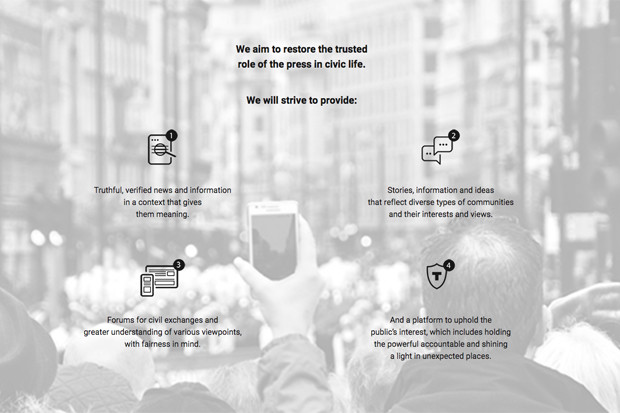The Trust Project, an international consortium of more than 75 news organisations who are collaborating to increase transparency in journalism, has released the Trust Indicators, a set of standardised disclosures aimed at providing clarity on a publication's standards, work process and its journalists' backgrounds.
The non-partisan initiative, led by award-winning journalist Sally Lehrman of Santa Clara University's Markkula Center for Applied Ethics, announced yesterday (16 November) that leading media companies around the world, as well as Google, Facebook, Bing and Twitter, are starting to use the indicators to give people more information about the stories they are reading to help them identify high-quality news.
Representatives from a variety of news outlets worldwide identified the indicators following in-depth interviews with members of the public about what makes information trustworthy, and decided on a set of eight core ones to implement first:
- Best practices: What are your standards? Who funds the news outlet? What is the outlet’s mission? Plus commitments to ethics, diverse voices, accuracy, making corrections and other standards;
- Author expertise: Who reported this? Details about the journalist who wrote the story, including expertise and other stories they have worked on;
- Type of work: What is this? Labels to distinguish opinion, analysis and advertiser (or sponsored) content from news reports;
- Citations and references: For investigative or in-depth stories, greater access to the sources behind the facts and assertions;
- Methods: Also for in-depth stories, information about why reporters chose to pursue a story and how they went about the process;
- Locally sourced? Lets people know when the story has local origin or expertise;
- Diverse voices: A newsroom’s efforts to bring in diverse perspectives;
- Actionable feedback: A newsroom’s efforts to engage the public’s help in setting coverage priorities, contributing to the reporting process, ensuring accuracy and other areas.
Each news organisation displays the indicators, both on individual article pages and on site-wide pages, according to their design, and they are integrated with a publisher's content management system and site code.
This is a mock-up of a story featuring the indicators, and there is also a Trello board available with links showing what they look like live on the websites of publishers who have started incorporating them.
The first set of news organisations to adopt the measure include German press agency dpa, The Economist, The Globe and Mail, the Independent Journal Review, Mic, La Repubblica, La Stampa, Trinity Mirror and the Washington Post, who worked closely together on the visual and technical aspects of the project. More news outlets will be able to join in the second round of the initiative.
The Trust Project is funded by the Craig Newmark Philanthropic Fund, Google, the Knight Foundation, the Democracy Fund, and the Markkula Foundation.
The Trust Project has also been working with the Institute for Nonprofit News to build and test a WordPress plug-in that allows smaller qualified outlets to participate.
"I think it will make a difference in how the public perceives what we do," Lehrman told Journalism.co.uk. "In our interviews, we found there was a lot of desire to be informed and to understand what is going on in the world, but people were very uncertain about what they could trust and wanted to know a lot more about what's behind the process of an individual article or the standards behind the site.
"So this really does pull back the curtain on all the due diligence that journalists go through in order to put a solid story together."
The Trust Indicators are also integrated into the latest Schema.org technical vocabulary, which allows technology companies to incorporate them in the way they display news stories.
Google, Facebook, Bing and Twitter are currently testing ideas for how to best implement them. For example, Google is hoping to "use the Type of Work indicator to improve the accuracy of article labels in Google News, and indicators such as Best Practices and Author Info in our Knowledge Panels", Richard Gingras, vice president of news products at Google, said in a release, while Facebook will be displaying the indicators through their additional context module launched in October.
"Over time, my hope is that the public will begin to notice these things on the various sites and notice when they're not there as well, to start developing more of a sense of what to look for in order to really be able to distinguish quality and trustworthy news from other types of news," Lehrman said.
Free daily newsletter
If you like our news and feature articles, you can sign up to receive our free daily (Mon-Fri) email newsletter (mobile friendly).
Related articles
- Schibsted gives young audiences what they want: transparency on editorial decisions
- Revenue and tech: Five must-read news reports for your newsroom
- What the news community says about Zuck’s plans to bin fact-checking
- Media analyst Thomas Baekdal: 'News publishers must stop fighting for the scraps of ad revenue'
- RISJ Digital News Report 2024: Three essential points for your newsroom












